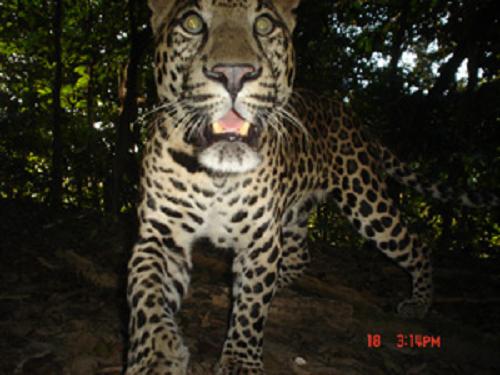Kashmira Kakati
This project aims to document the presence of carnivores in the Jeypore-Upper Dehing wet evergreen forests of Assam, and use the results to bring this threatened lowland habitat into conservation focus.

Leopard.
The sub-tropical Jeypore-Upper Dehing forests of Upper Assam are part of the Eastern Himalaya/Indo-Burma Biodiversity Hotspot. They are among the last remaining tracts (>500 km²) of the previously extensive Assam Valley Wet Evergreen forest, and indeed among the last bits of rainforest left on the lowlands in Northeast India. These forests are one of the most important refuges of the highly endangered hoolock gibbon, counted among the 25 most endangered primates in the world. It also supports a population of about 250 Asian elephants, and is breeding habitat of the globally endangered white-winged wood duck. The globally critically endangered Vatica lanceaefolia is one of the dominant tree species here. Other wildlife are poorly documented and in spite of its importance as a watershed and wildlife habitat, the forests have remained in the periphery of conservation focus. Recently, only a small part (111 km²) of this landscape was upgraded to protected area.
The forests have a exploitation history spanning over a century by the timber, tea, oil and coal mining industries. Oil-fields continue to be operational in the Upper-Dehing forests. Human settlements, rampant illegal logging and high levels of disturbance in the form of firewood and other forest produce collection add to the very real threat that the forest might not only completely degrade and fragment, but simply disappear as has happened in other areas of Assam recently. There are also reports and evidence of illegal hunting - mostly for local consumption of deer and wild pig meat, but possibly also for trade in products such as ivory.
My objective in this project is to document the presence of carnivores in this landscape through camera-trapping, and use the photographic evidence of this elusive group of animals to add to the arguments for conserving this threatened landscape. Carnivores are a critical indicator group of the integrity of natural systems and I hope that evidence of the presence of charismatic and rare species in this habitat will influence policy-makers, government and the industries operating here to have a good re-look at this forest and shape their actions accordingly. One of the project outputs will be the production of a poster with the camera-trap photographs for generating public awareness.
In the long term, I hope to carry out a scientific forest restoration program in collaboration with the forest department and the mining companies, which will include establishment of forest corridors to connect the disjointed parts of the forest complex.